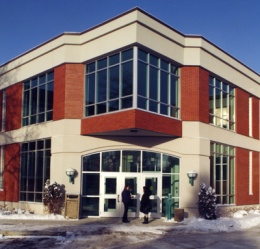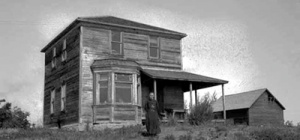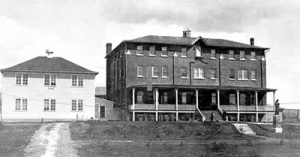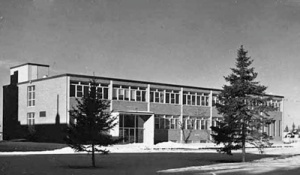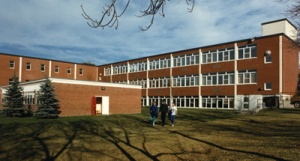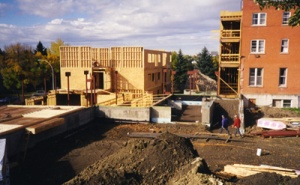College Saint Jean of Alberta
par Levasseur-Ouimet, France and McMahon, François
In 1997, Alberta's Collège Saint-Jean received the Prix du 3-juilet-1608 from the Conseil de la Langue Française [Council for the French Language], the Quebec government's French-language enrichment (and conservation) agency. This award recognized the important contribution made by the college in promoting French language and culture in North America, as well as the key role it played (and continues to play) within the Franco-Albertan community. For close to 100 years, Alberta's French speakers have benefitted from the vitality and influence of this institution, which is now recognized throughout Canada for its quality post-secondary education programs, and indeed around the world for its research activities.
Article disponible en français : Collège Saint-Jean en Alberta
Building Collège Saint-Jean
The history of Collège Saint-Jean stretches over an entire
century. In 1908, the Oblate Fathers [OMI: Oblates of Mary Immaculate] founded
a juniorate in Pincher Creek, an institution which was originally a training
centre for young men intending to join a religious order. The Juniorate moved
to Edmonton in 1910 and settled in its current home in 1911. The Oblate Fathers
constructed the main building, which was expanded and given a facelift in 1921.
The school's administrators never allowed the government to give the building
official historic status, because such a designation would have indeed made any
subsequent alteration very complicated. They counted on the community to make
sure that the historic building remained intact.
In 1927, Rome decreed that the provincial Oblate of Alberta-Saskatchewan would henceforth be exclusively French. Consequently, the very next year Juniorat Saint-Jean, until then a bilingual establishment, became a French-language institution, officially affiliated with the University of Ottawa. In 1931, Saint-Jean adopted the secondary school programs of Alberta's Ministry of Education, in order to make the province's various university faculties more accessible to its graduates, who could now complete grade 12 according to provincial standards, all the while maintaining the classical education programs that still predominated in French Canada at that time. In 1941, when Edmonton's Collège des Jesuits closed, Alberta's French-speaking community was obliged to turn to Saint-Jean, which thereafter accepted to educate young men pursuing non-religious vocations. At this point, the institution chose the name Collège Saint-Jean and became the main centre of education for young French-speaking men from the entire province of Alberta.
Beginning in 1908, the college added a number of new buildings to the original structure. In 1917, the Maison Blanche [White House] was constructed. In 1921, annexes were added onto the initial building; a new gymnasium and new residence halls were erected in 1950; a new classroom building was built in 1960; and finally, an administration building was inaugurated in 1964. The first construction projects were funded by the Provincial Administration of the Oblates of Alberta and by the Franco-Albertan community. In addition, after 1964, College Saint-Jean would receive financial support from the governments of Quebec and Canada.
By 1961, when the college celebrated its 50th anniversary, the number of alumni had increased to over 2,000. Arthur Lacerte, the school's Religious Superior and Rector since 1957, was the latest in a long line of priests who had held the position before him: André Daridon, Joseph Lebris, Alphonse Simon, Thomas Schnerch, Albert Naessens, HenriRouthier, Amédée Nadeau, Jean Patoine, Valérien Gaudet, and Fernand Thibault. In 1967, Father Lacerte was replaced by François McMahon, who would first serve as Rector of College Saint-Jean and then as dean of the Collège Universitaire and the Saint-Jean faculty until 1980. After McMahon was named dean, Father Paul Poirier would become the last Oblate father to be appointed College Rector.
Collège Saint-Jean: Growing into University Status
The decade between 1960 and 1970 was one of the most active periods in the school's history. The era began with the arrival of the first female students, as officials sought to ensure that from then on young ladies would also have access to a post-secondary education in French. A teacher-training school was also created in partnership with Laval University, whose charter allowed it to establish branches all across Canada. However, only one month after it opened in September 1961, the school came under a threat. The University of Alberta, which until then had enjoyed a provincial monopoly on teacher training, had great difficulty accepting the reality that another university would be offering a similar program on its home territory. The storm subsided in 1963 when the college's education program became affiliated with that of its erstwhile rival. In 1966, it was the turn of Saint-Jean's arts program to link up with the University of Alberta, marking the end of the college's affiliation with the University of Ottawa.
On 27th November 1970, Saint-Jean became the Collège Universitaire Saint-Jean and immediately thereafter integrated a master's level education centre into its pedagogical structure. The creation of this centre was made possible by a change in the Alberta School Act, which allowed graduate intruction to be conducted in French. In addition, from 1968 to 1972, in collaboration with the Edmonton General Hospital, Saint-Jean offered the only bilingual nursing course in Western Canada, along with a two-year post-secondary education program available nowhere else in Edmonton. In 1970, the Catholic School Board decided to found a bilingual secondary school, the J. H. Picard School, which would bring together the secondary-level students from Collège Saint-Jean and Académie Assomption.
In 1974, the Oblates announced their desire to sell the institution to the University of Alberta, which officially took over the property and buildings on May 1st, 1976. Saint-Jean became a University of Alberta division in 1977, whose mission thereafter would be to "meet the special needs of French speakers throughout Western Canada." From that time on, Saint-Jean became free to offer its own programs without ever needing to ask permission from other University sectors, as was the case for all the other faculties. Taken together, all of these events marked the passing of one phase and the beginning of a new one.
At first, the new faculty focused its efforts in three areas: a general program that would include the arts, social sciences, and natural sciences; a teacher-training program; as well as a French program. Accordingly, as of 1982, Saint-Jean offered seven new education programs, which were designed to provide professional training in areas that only they could uniquely offer. In 1987, the University of Alberta Board of Governors approved two new diplomas in Advanced French Education. In order to meet the growing needs of the area's French-language schools, Saint-Jean also created a program that specialized in training students wishing to teach in a minority French-language context. This Master's in Education was approved in 1992.
In addition, during this period the Saint-Jean Faculty also became increasingly active on the international scene. For instance in 1998-1999, an agreement was signed with the Institut Universitaire de Formation des Maîtres de Toulouse [University Institute of Toulouse for Teacher Training]. In 1999, another agreement was made with the Paris-based Institut de Gestion Social [Institute of Public Administration], as part of the bilingual Business Administration program.
The 1990s were characterized by the growth of new programs and the consolidation of others. As of 1987, Saint-Jean offered a brand-new arts program, followed by the creation of a new major in Canadian Studies that was inaugurated in the fall of 1996. In 1999, Saint John established the Louis Desrochers Professorship to recognize the emergence of interdisciplinary research in Canadian studies.
Course offerings continue to diversify; for, as of 1997, several new ones were made available, including a bilingual B. A. in Business Administration, developed in conjunction with the University of Alberta's School of Business. In September, 2000, Saint-Jean established a partnership with the Faculty of Engineering that made it possible to offer first-year engineering student courses taught in French that are supervised by the University faculty. In 2001, Saint-Jean set up a Centre for Canadian Studies and inaugurated the Louis Desrochers conferences, a series of lectures that would, in 2002, feature a presentation by Beverley McLachlin, Chief Justice of the Supreme Court of Canada. Also in 2001, Saint-Jean was awarded the Canada Research Chair in Political Philosophy and in Canadian Studies. In 2002, the Master's program in Arts and Canadian Studies received final approval, and then, in September of 2004, the bilingual B. A. in nursing was launched.
Between Educational Excellence and Promoting the Arts
Between 1997 and 2001, the Saint John campus underwent a number of other changes. The official opening of its new library, multi-media room and renovated office space was celebrated on January 17th, 1997. On June 16th, 1999, the traditional first shovelful of earth was turned, marking the beginning of the work on a new student residence, which would be called the Centre Résidentiel Saint-Jean. The formal re-opening of a newly renovated building re-named Centre Saint-Jean, which was originally constructed in 1910-1911, was celebrated on May 24th 2001. This building is now called the Pavillon Lacerte, while the buildings constructed in 1960 and 1964 are known collectively as the Pavillon McMahon.
Over the years, Saint-Jean has been singularly active in the area of the fine arts. The institution began investing in theatre as early as 1911, when the young students presented their very first play. From 1954 to 1967, Saint-Jean's theatrical activities did not go unnoticed, particularly its productions of Molière's works, as well as its founding of new companies such as the Collégiens Commédiens (1963) and the Rideau Rouge [Red Curtain] (1967). In addition, for a number of years, Saint-Jean was home to Edmonton's Théâtre Français, with the college's auditorium serving as the main theatre for the community. In 2007, the three Western Provinces were preparing to establish a new theatre studies program intended to foster new collaboration between Collège Saint-Jean and Western Canada's French-speaking communities.
From its beginning, and especially since 1943, the school=s campus has served as a meeting-place for numerous Francophone associations. The Maria Goretti Studies and the Saint John student radio service participated in the activities of the CHFA, for many years Alberta's only French-language radio station. The province=s first Albertan Festival of Song and the first Interprovincial French-language Festival of Song also took place at Saint John. Renovations of the Lacerte Pavilion (2002) paved the way for the construction of the Grand Salon, a large-scale meeting hall that could truly be termed the AGrand Salon of the French-speaking world@ C so often has it been used for many meetings of Francophone organizations which are not linked to the University.
The Saint John Faculty and Franco-Albertan Heritage
In addition to its contribution to the field of arts, Saint John also provides the French-speaking community with numerous specialised services. Established in 1982, its Service de l'Éducation Permanente [Department of Continuing Education] has offered a variety of courses for nearly 20 years. Since 1977, Saint-Jean's Centre of Pedagogical Documentation has given teaching personnel access to significant resources associated with their particular field. In 2006, at the request of the Fédération des Aînés Franco-Albertains [Franco-Albertan Federation for Senior Citizens], Saint-Jean set up the University du Troisième Âge, its department for seniors. That very same year, the provincial government invited Saint John to create a proposal for establishing a French-language college program which, pending approval, was slated for implementation in September of 2007.
Since the 1950s, Saint John has made a special effort to promote Franco-Albertan heritage. In addition to the Salon d'Histoire, organized in 1974, Saint John inaugurated the Salle Durocher in 1987; both housed the Saint-Jean archives for a certain length of time before they were transferred to the Lacerte Centre in 2005. In 2000, Saint John celebrated the opening of its new Salle Historique, then in 2001, its Institut pour le Patrimoine de la Francophonie de l'Ouest Canadien [Institute for the Heritage of French-speaking Western Canada]. The Institute is in charge of developing the Salle Historique and has already published two major volumes, one of which is D'année en Année: de 1639 à 2000: une Présentation Synchronique des Événements Historiques Franco-Albertains(NOTE 1), the first historical overview of the Franco-Albertan community.
Over the course of its 100-year history, Saint John has always found ways to meet the needs of the Franco-Albertan community. After the Saint-Joachim neighbourhood was turned into a district of residential high-rises and office buildings, the French quarter was in fact relocated near Saint-Jean. The campus, with its trademark redbrick buildings, remains a sign of the visible presence of Alberta's French speakers, who have lived in the province for over 100 years. For thousands of students of all ages, and for members of the Franco-Albertan community, Saint John represents more than just another school. Indeed, in addition to its pedagogical purpose, Saint John has unceasingly played a key role in preserving French-language culture in Alberta. The institution has helped maintain the vitality of this community, which is geographically isolated from Canada's main French-speaking population centres, and has done its part to ensure that the community's heritage will be handed on to future generations.
François McMahon
France Levasseur-Ouimet
Saint-Jean Campus, University of
Alberta
NOTES
Note 1: France-Levasseur-Ouimet, D'année en année: de 1659 à 2000: une présentation synchronique des événements historiques franco-albertains. Edmonton: Institute of Western Canadian Francophone Heritage, 2003, 422 pages. The title translates roughly as: [1659-2000: A Year-by-Year Presentation of Franco-Albertan History]
Additional DocumentsSome documents require an additional plugin to be consulted
Images
-
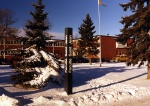 Collège St-Jean
Collège St-Jean
-
 Edmonton - Juniorat S
Edmonton - Juniorat S
t.-Jean, harves... -
 Edmonton – College St
Edmonton – College St
. Jean building... -
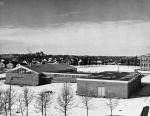 Edmonton – Collège St
Edmonton – Collège St
.-Jean, dortoir...
-
 Edmonton – Juniorat S
Edmonton – Juniorat S
t-Jean, [1938].... -
 Edmonton – Juniorat S
Edmonton – Juniorat S
t-Jean, premier... -
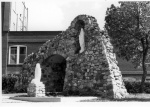 Photo de la grotte de
Photo de la grotte de
Notre-Dame de ...

